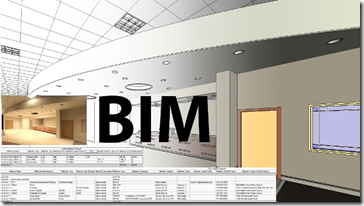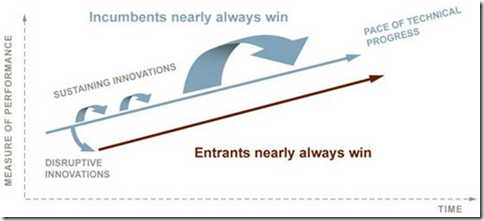 Moving Building Information Modeling to the cloud has two innovation paths, a disruptive innovation in BIM path or a merely incremental or sustaining innovation path. Presently progress on either path is retarded (slowed) from a more significantly transformational transition. A powerful vision for cloud-based BIM is developing potential like a thunder storm forms at the convergence of cold and warm fronts. It is a Great Vision – and it WILL happen, eventually. However, it is not a vision that will be achieved by incrementally by merely improving collaboration, data, and lifecycle management solutions for existing building industry customers and users.
Moving Building Information Modeling to the cloud has two innovation paths, a disruptive innovation in BIM path or a merely incremental or sustaining innovation path. Presently progress on either path is retarded (slowed) from a more significantly transformational transition. A powerful vision for cloud-based BIM is developing potential like a thunder storm forms at the convergence of cold and warm fronts. It is a Great Vision – and it WILL happen, eventually. However, it is not a vision that will be achieved by incrementally by merely improving collaboration, data, and lifecycle management solutions for existing building industry customers and users.
Clearly, the cloud and new client platforms are key to a disruptive innovation for BIM and this industry’s value chain. A truly profound disruptive innovation in BIM will require a complete rethink of the value of BIM data on several fronts, including:
- The development of new ways to create value from BIM data and modern cloud and client computing architectures.
- The exploration of new ways to deliver value to new segments with needs far outside traditional BIM thinking.
- The execution of programs, plans and initiatives to sustain value on its new course to serve a broader market.
A good description of the industry-sustaining aspects of that future vision was published on the Building Design + Construction network recently, called “BIM’s future up in the cloud,” by Dominic Thasarathar.
The Challenge for Disruptive Innovation in BIM
Unfortunately, current innovation toward a cloud-based BIM is “evolutionary,” and not “disruptive” in the canonical sense that Harvard professor Clayton Christensen has taught us. Presently, technology providers deliver, and customers and users have the propensity to absorb, only incremental innovation. That is, evolutionary breakthroughs and incrementally small-step sustaining improvements to existing products and services.
These easy to absorb innovations primarily automate slow process or smooth out rough points. Sustaining innovation does nothing to re-engineer legacy BIM processes in a disruptive way. [You can review Clayton Christensen’s explanation for disruptive innovation at this link.]
Legacy processes ripe for disruptive innovation in BIM include just about everything. That is to say everything that creates BIM data and all primary, secondary, tertiary, and other touch points. It includes hallowed legacy processes from program management, engagement with owners and operators, to the entire Professional Practices Manuals that are followed today, and which technology has largely focused on automating and is presently moving to the cloud.
Disruptive Factors or Drivers
To truly achieve this imagined world for BIM and to provide value in the grand new way described in the article, two things must change. Price must come down, and technology must be easier to use. Price must fall to enable and allow access to a greater population of customers and users. Technology must be dramatically easier to use, have massive performance improvements, and significant capability progress.
These things must transform BIM as a product and service away from its current form which is complex and access-restricted. BIM must become more affordable and accessible to a bigger population. Taking this disruptively transformational approach increases the population that can be involved in a building project, and maximizes the potential outcome.
Convergence
Clearly, there is a convergence of technology happening, usability practices, user interfaces, cloud computing and multi-client ubiquitous access anywhere, anytime…, but the tipping point has not yet been achieved. Who are the new customers? How can they be identified well enough to have strategies put in place to capitalize on their potential? These are the most difficult questions to answer.
 We know that a strategy of acquiring more collaboration, data and infrastructure technologies to glue together an incrementally-better solution to sustain the interest of existing customers like owners, architects, engineers, contractors, tradesmen, operators, and so on, will eventually not be enough. Further, this creates a vacuum of opportunity for a new provider to provide a truly disruptive solution. Clayton Christensen’s model below, shows how new entrants nearly always win.
We know that a strategy of acquiring more collaboration, data and infrastructure technologies to glue together an incrementally-better solution to sustain the interest of existing customers like owners, architects, engineers, contractors, tradesmen, operators, and so on, will eventually not be enough. Further, this creates a vacuum of opportunity for a new provider to provide a truly disruptive solution. Clayton Christensen’s model below, shows how new entrants nearly always win.
We can say with confidence that eventually a point will come where more sustaining innovation will not be enough to serve the either traditional players in the BIM industry or a new population of customers and users that heretofore did not have access. It will be, some new innovation that expands access, and delivers BIM in new ways to more people that are not yet involved in BIM’s potential future value chain.
To Ponder
There are some textbook factors at play around industries, markets, innovation vendors and legacy technologies. As I noted at the beginning, this transition WILL happen, and it would be best if it was driven by the leading forces in the industry that can best achieve the transition for customers and users.
Identifying and involving the new untapped population of customers and users that a disruptive innovation in BIM will achieve has great unmeasured potential. For me, that is the real stretch of the mind to imagine – a much bigger stretch than to imagine BIM technology in the cloud environment. The technology is easy – the transformational change will be the challenge. Changing the legacy processes, opening up design information to more access and changing age-old traditions that don’t apply anymore will be the real challenge. I think we can say, however, if we can see through the challenge, take the risk, and get to the future – it will be a much better place with enormous advantage.
Final Note
The advance and convergence of technology makes this a marketing and strategy problem, not a technology problem.
[Image Credit: BIM – Building Information Modeling From Richard Binning Via Wikimedia Commons.] [Image Credit: Disruptive Innovation From Clayton Christensen via http://ClaytonChristensen.com on 11Aug2012]









